Comparative Development Experiences of India and its Neighbours Class 12 Economics
Introduction
With the process of globalisation underway, developing countries are eager to learn about the development methods used by their neighbours as they face competition from both developed nations and each other.
In today’s globalised world, where geographical borders are becoming less significant, it is crucial for neighbouring countries in the developing world to grasp the development strategies being adopted by their peers. This understanding is vital, especially since they share the limited economic space available to developing nations.
As a result, countries are forming regional and global economic groups like SAARC, the European Union, ASEAN, G-8, G-20, and BRICS. Understanding the economies of neighbouring countries is essential, as it helps nations better recognise their own strengths and weaknesses in relation to those around them.
Comparative Development Strategies
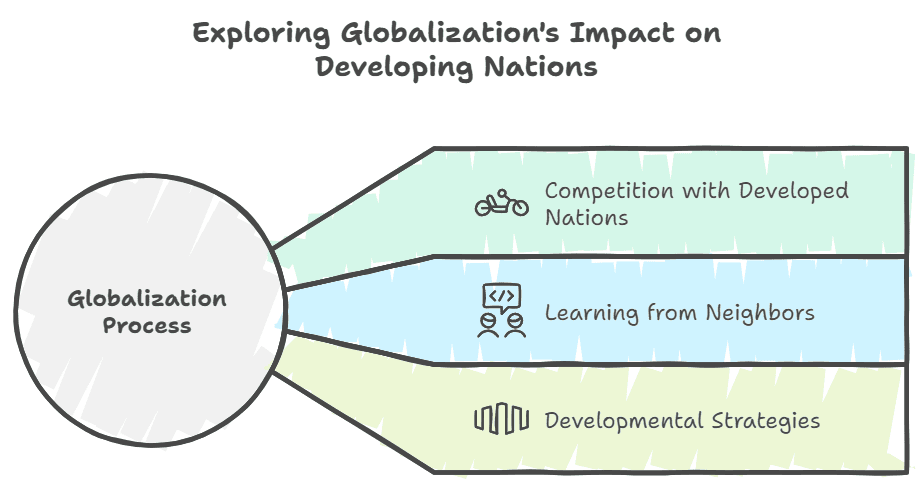
In this chapter, we will examine the development strategies of India and its two largest neighbouring economies—Pakistan and China.
As John F. Kennedy famously said, “Geography has made us neighbours. History has made us friends. Economics has made us partners, and necessity has made us allies.” This interconnectedness highlights the significance of collaboration and understanding among nations.
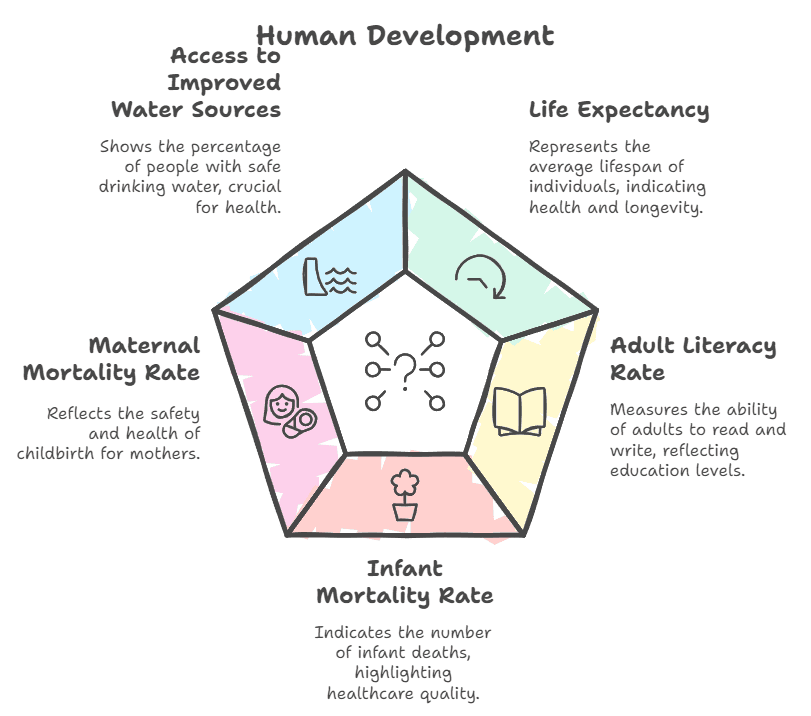
- In today’s globalised world, where borders are less important, it is crucial for developing countries to understand each other’s development strategies.
- This connection underlines the need for cooperation and mutual understanding among nations.
- China’s industrial sector has seen strong growth, unlike India and Pakistan.
- The SEZs (Special Economic Zones) policy of China is key in attracting foreign direct investment (FDI) through robust infrastructure that supports economic growth.
- India's dependency on agriculture is significant even after seventy years of planned development.
- China's demographic policies, particularly the one-child policy from 1979, have influenced its population growth and economic standing, leading to slower population growth compared to India, which faces challenges with a larger, younger population.
Development Path of India, Pakistan, and China
Overview of Development Paths
- India and Pakistan gained independence in 1947, while the People's Republic of China was established in 1949. Jawaharlal Nehru remarked that these events reflected a new spirit in Asia, stating, “These new and revolutionary changes in China and India, even though they differ in content, symbolise the new spirit of Asia and new vitality which is finding expression in the countries in Asia.”
- All three countries began their development planning in similar ways: India initiated its First Five Year Plan in 1951, followed by Pakistan in 1956 and China in 1953.
- India and Pakistan adopted similar approaches, such as creating a large public sector and increasing social development spending, but the systems set up to implement these policies vary significantly.
- Both India and Pakistan embraced a mixed economy model, whereas China has followed a traditional development approach, gradually moving from agriculture to manufacturing and then to services. India is the world's largest democracy with a secular constitution, contrasting with Pakistan's military-based system and China's command economy.
- Up until the early 1980s, the growth rates and contributions to national income in all three countries were comparable. Even after seven decades of planned development, a large part of the workforce in all countries relies on agriculture, with India having the highest dependency.
- China enacted structural reforms in 1978 independently, while Pakistan did so in 1988 under international pressure, and India followed in 1991, also influenced by external factors. The effects of these policy changes varied; for instance, the one-child policy in China has slowed population growth, while in India and Pakistan, significant changes are still awaited.

Development Strategy
1. Development Strategies of India
- A Sound Trade System: It's important to note that even though India has ample natural resources, its political structure differs significantly from that of Pakistan, which has a militaristic approach, and China, which has only recently begun to adopt democratic and more liberal economic reforms.
- Poverty Reduction: India has initiated several programmes aimed at reducing poverty, with the goal of increasing per capita income and enhancing nutrition.
- Rural Development: The country has implemented strategies to uplift underdeveloped regions, concentrating on boosting the village economy.
- Employment Generation: Nevertheless, the frameworks established to execute these developmental policies vary considerably.
India, Pakistan, and China share various similarities in their development approaches, having embarked on their developmental journeys around the same period. India and Pakistan gained independence in 1947, while the People's Republic of China was formed in 1949. Understanding this historical context is vital for comprehending the development paths of these countries.
2. Development Strategies of China
- Since the establishment of the People’s Republic of China in 1949, the government has controlled critical sectors, including private enterprises and land.
- The Great Leap Forward (GLF) programme in 1958 aimed to rapidly industrialise the country by encouraging home-based industries.
- In 1965, Mao Tse Tung introduced the Great Proletarian Cultural Revolution (1966-1976), sending students and professionals to rural areas for work and learning.
- A commune system was created in rural areas, allowing collective farming.
- China's reforms were implemented in phases, starting with agriculture and foreign trade, before moving to industry.
- The reform process included dual pricing, where certain raw materials were sold at fixed government prices, while others were traded at market rates.
- Special Economic Zones (SEZ) were established to attract foreign investors, offering different economic regulations than the rest of the country.
- Before reforms, China made significant public investments in social infrastructure, positively affecting human development indicators.
- China's one-child policy has had a significant impact on population growth, contrasting with the situations in India and Pakistan.
3. Development Strategies of Pakistan
- Pakistan has adopted a mixed economy, combining both public and private sectors.
- It uses tariff protection for manufacturing consumer goods and has direct import controls on competing imports.
- The Green Revolution introduced mechanisation and increased public investment in specific areas, leading to a rise in foodgrain production and a significant change in agrarian structure.
- In the 1970s, capital goods industries were nationalised.
- In the late 1970s and 1980s, the policy focus shifted to denationalisation and encouraging the private sector.
- To attract foreign investors, special economic zones were established.
- Pakistan has also gained from financial help from Western nations and remittances from emigrants in the Middle East.
Success and Failure of Strategies
The development strategies brought structural reforms in China, India, and Pakistan. Below is a description of their successes and failures.
The Success of Structural Reforms in China
- There was enhanced infrastructure in education and health, along with land reforms.
- The long-standing decentralised planning and small enterprises helped improve social and income indicators after the reforms.
- The commune system led to a fairer distribution of food grains.
- Before the reforms, there was already a large expansion of basic health services in rural areas.
- The one-child policy has slowed population growth in China, unlike in India and Pakistan, where significant changes are still needed.
China initiated structural reforms independently, while India and Pakistan were compelled by international agencies. The effects of these policy measures varied across these countries.
Failures of Structural Reforms in China
- The new leadership in China was dissatisfied with the slow growth and lack of modernisation in the economy during Maoist rule.
- The Maoist approach to economic development, which focused on decentralisation, self-sufficiency, and avoiding foreign technology, goods, and capital, did not succeed.
- Despite widespread land reforms and collectivisation, the amount of grain produced per person in 1978 was the same as in the mid-1950s.
- After seventy years of planned development, a large part of the workforce in many countries, especially India, still relied on agriculture.
- Reforms began in China in 1978, which are key to understanding the shortcomings of structural reforms.
- Improvements in infrastructure related to education and health positively influenced social and income indicators after the reforms.
- The commune system enabled a fairer distribution of food grains.
Comparative Timeline of Reforms
- Reforms began in China in 1978, followed by Pakistan in 1988, and India in 1991.
- China's structural reforms were self-initiated, whereas India and Pakistan faced reforms imposed by international organisations like the World Bank and the International Monetary Fund.
- The Chinese leadership at the time was dissatisfied with the slow growth and lack of modernisation under Maoist policies.
China has an Edge Over India
- The Chinese reform process started more thoroughly in the 1980s, while India was experiencing slow growth.
- China outperforms India and Pakistan on several human development measures, but these gains are largely due to the strategies used before the reforms.
- Rural poverty in China has dropped significantly, making it the country with the fewest poor people among China, India, and Pakistan, which is important for comparing poverty levels.
- China's industrial sector has seen a high growth rate, unlike India and Pakistan. China's economy has been more exposed globally than India's.
- China has followed a traditional development path, moving from agriculture to manufacturing, then to services, whereas India and Pakistan have transitioned straight from agriculture to services.
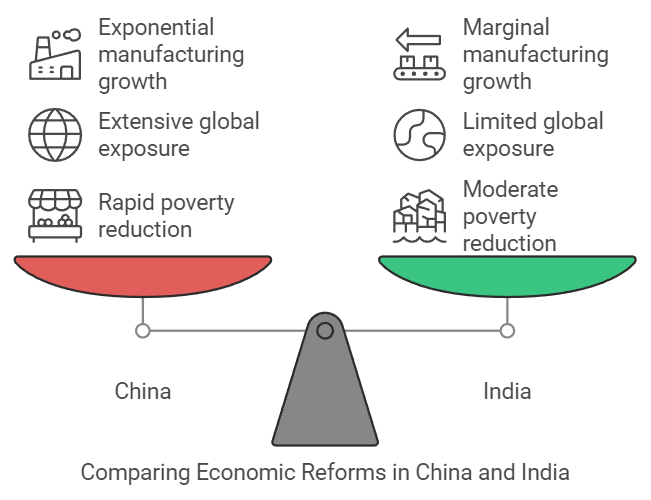
Common Success of Structural Reforms in India and Pakistan
Key Achievements
The common success of structural reforms in India and Pakistan includes the following:
- Both countries have more than doubled their per capita incomes since reforms began, with Pakistan starting in 1988 and India in 1991, despite heavy reliance on agriculture.
- The level of poverty has significantly decreased, but comparing poverty levels between the two countries is complex and needs more context.
- Both nations have reached self-sufficiency in food production.
- The industrial and service sectors have seen growth rates of 4.9% and 6.2% respectively, although these rates vary across different sectors.
- There has been greater adoption of modern technology, showing the impact of reforms.
It is essential to understand that while China initiated structural reforms in 1978, India and Pakistan implemented theirs under pressure from international agencies, affecting their development paths.
Despite these improvements, a large part of the workforce in both countries still relies on agriculture, with a greater dependency in India, even after seventy years of planned development.
Economic Development Strategy After Independence
Overview of Economic Roles
- Both the public and private sectors were tasked with handling business activities. The public sector oversaw areas like coal, mining, steel, power, and roads. The private sector could set up industries under government regulations.
- The government significantly supported the public sector. Investment rose from Rs. 81.1 crore in the First Five-Year Plan (1951-56) to Rs. 34,206 crores in the Ninth Five-Year Plan (1992-97).
- State Owned Enterprises (SOEs) played a vital role in the public sector, aiding in industrialisation and economic growth, and helped achieve a level of self-sufficiency in India.
- The Green Revolution greatly changed agriculture, boosting food production and public investment in infrastructure, which helped economic growth.
- In the 1970s, the nationalisation of capital goods industries marked a major shift in economic policy, aiming to strengthen public sector control in key industries.
- Public sector enterprises started to face competition due to economic reforms, which brought in market dynamics and challenged their operational models.
- The effect of foreign investment and the creation of special economic zones (SEZs) further transformed the economic landscape, promoting growth and modernisation in different sectors.
Common Failures of Structural Reforms in India and Pakistan
- Reforms began in China in 1978, Pakistan in 1988, and India in 1991, marking key moments in their economic strategies.
- Growth rates of GDP and its sectors have not improved compared to the 1980s in both countries.
- Studies using official data from Pakistan show a rise in poverty, with many people living below the poverty line, especially from the 1960s onwards.
- Poverty and unemployment remain critical issues in both nations, with ongoing struggles to enhance human development measures.
- In India, growth rates after reforms have differed across sectors, with agriculture, industry, and services showing various patterns that reveal the complexities of the reform efforts.
Reasons for Reform Outcomes
China initiated structural reforms in 1978 due to dissatisfaction with slow growth and limited modernisation under Maoist policies. The new leadership was frustrated with the sluggish growth and lack of progress in modernising the Chinese economy during Mao's rule. They recognised that the previous economic strategy, which emphasised decentralisation and avoiding foreign technology, had not produced the desired outcomes.
In contrast, scholars contend that in Pakistan, the reform process has resulted in deteriorating economic indicators. Despite initiating reforms, the expected improvements in GDP growth and poverty alleviation have not materialised, leading to a prolonged economic crisis.
Comparative Health and Development Indicators of Pakistan and India
Key Indicators
- Migration of workforce from agriculture to industry.
- Urbanisation: Movement of people from rural to urban areas.
- Access to Clean Water: All three countries report providing improved drinking water sources for most of their populations.
- Poverty Reduction: Pakistan and India have made progress in reducing the number of people living below the poverty line.
When it comes to maternal health, the figures are alarming. In China, only 29 women die from maternal causes for every one lakh births, while in India and Pakistan, the numbers are much higher at around 133 and 140 women, respectively.
Areas where India has an Edge Over Pakistan
- India has a more skilled workforce and better research institutions.
- Indian scientists excel in fields such as defence technology, space research, electronics, avionics, genetics, and telecommunications.
- India produces a significantly larger number of Ph.Ds in science and engineering than Pakistan; however, specific figures for Pakistan are not available.
- The infant mortality rate is 29.9 per 1000 live births in India, while in Pakistan, it is 57.2 per 1000 live births.
- India's maternal mortality rate stands at 133 per 1 lakh births, compared to 140 in Pakistan.
- Approximately 21.9% of people in India live below the poverty line, while the figure for Pakistan is 24.3%.
Comparative Study – India, Pakistan, and China
1. Demographic Indicators
- The population of Pakistan is relatively small, making up about one-tenth of the population of China or India.
- Even though China is the largest country in terms of land, it has the lowest population density compared to the other two.
- The highest population growth rate is in Pakistan, followed by India, with China experiencing slower growth due to its one-child policy.
- All three nations have a low sex ratio that favours males because of a strong preference for sons.
- China has a low fertility rate, while Pakistan's rate is very high.
- China has the smallest percentage of poor people among the three and a high level of urbanisation, with India having 34% of its population living in cities.
2. Gross Domestic Product (GDP) and Sectors
- China boasts the second largest GDP (PPP) globally at $22.5 trillion, followed by India at $9.03 trillion and Pakistan at $1.06 trillion.
- The average growth rate in China is about 10.3%, with India at 5.8% and Pakistan at 4.1%.
- In 2011, 37% of China's workforce was in agriculture, contributing around 9% to its GDP. In India and Pakistan, agriculture contributed about 19% and 21% to GDP, with 56% and 45% of their workforces in agriculture, respectively.
- Manufacturing is the largest part of China's GDP at 47%, while in India and Pakistan, the service sector makes up over 50% of GDP.
- China has followed a traditional path of development from agriculture to manufacturing to services, while India and Pakistan have transitioned directly from agriculture to services.
- In the 1980s, India, China, and Pakistan had 25%, 33%, and 35% of their workforce in the service sector, respectively. By 2011, these figures rose to around 35%, 40%, and 45%.
- China's growth is mainly driven by manufacturing, while the service sector is becoming increasingly significant for both India and Pakistan.
3. Human Development Indicators
- Life Expectancy at Birth (years): India 69.7, China 76.9, Pakistan 67.3.
- Mean Years of Schooling (% aged 15 and above): India 6.5, China 8.1, Pakistan 5.2.
- Infant Mortality Rate (per 1,000 live births): India 29.9, China 7.4, Pakistan 57.2.
- Maternal Mortality Rate (per 1 lakh births): India 133, China 29, Pakistan 140.
Human Development Indicators: A Comparison of India, China, and Pakistan
Table 8.5 shows that China is advancing more than India and Pakistan in various human development indicators. China has outperformed both countries in several important areas, including:
- Gross National Income per capita (PPP US$): China leads with $16,057, followed by India at $6,681 and Pakistan at $5,005.
- Life Expectancy at Birth (years): China's life expectancy is 76.9 years, whereas India is at 69.7 years and Pakistan at 67.3 years.
- Infant Mortality Rate (per 1000 live births): India has an infant mortality rate of 29.9, while Pakistan has 57.2, and China has the lowest at 7.4.
- Maternal Mortality Rate (per 1 lakh births): China reports only 29 maternal deaths during childbirth, while India and Pakistan have much higher rates at 133 and 140, respectively. This highlights the serious health service issues faced by India and Pakistan.
Additional Indicators
The Human Development Index (HDI) values for each country are as follows: India: 0.645, China: 0.761, Pakistan: 0.557, with respective ranks of India: 130, China: 87, and Pakistan: 154. The average years of schooling are also notable: India: 6.5, China: 8.1, Pakistan: 5.2.
China and Pakistan are also more effective than India at reducing the percentage of people living below the poverty line, with figures of India: 21.9%, China: 1.7%, and Pakistan: 24.3%. The population using at least basic sanitation is reported as follows: India: 60%, China: 75%, Pakistan: 60%. In terms of access to basic drinking water sources, the percentages are: India: 93%, China: 96%, Pakistan: 91%.
Undernourishment in children is a significant issue, with rates of 37.9% in India, 37.6% in Pakistan, and only 8.1% in China.
Summary of Selected Indicators of Human Development
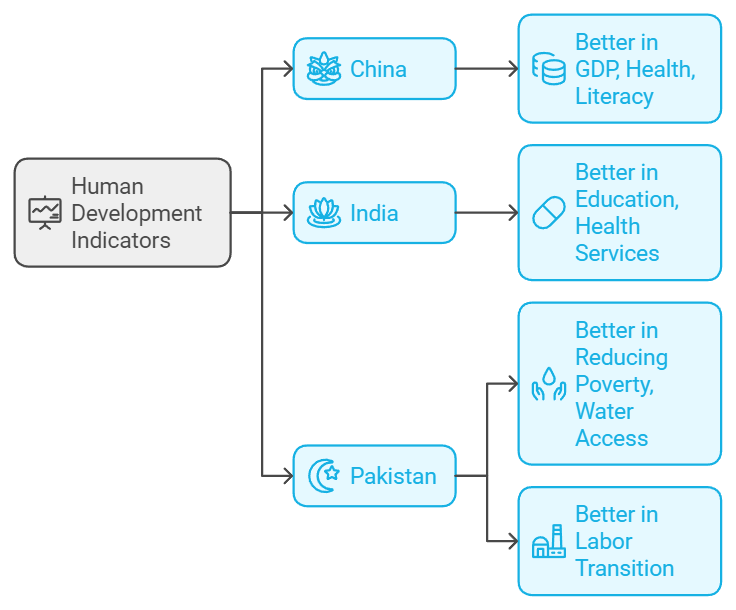
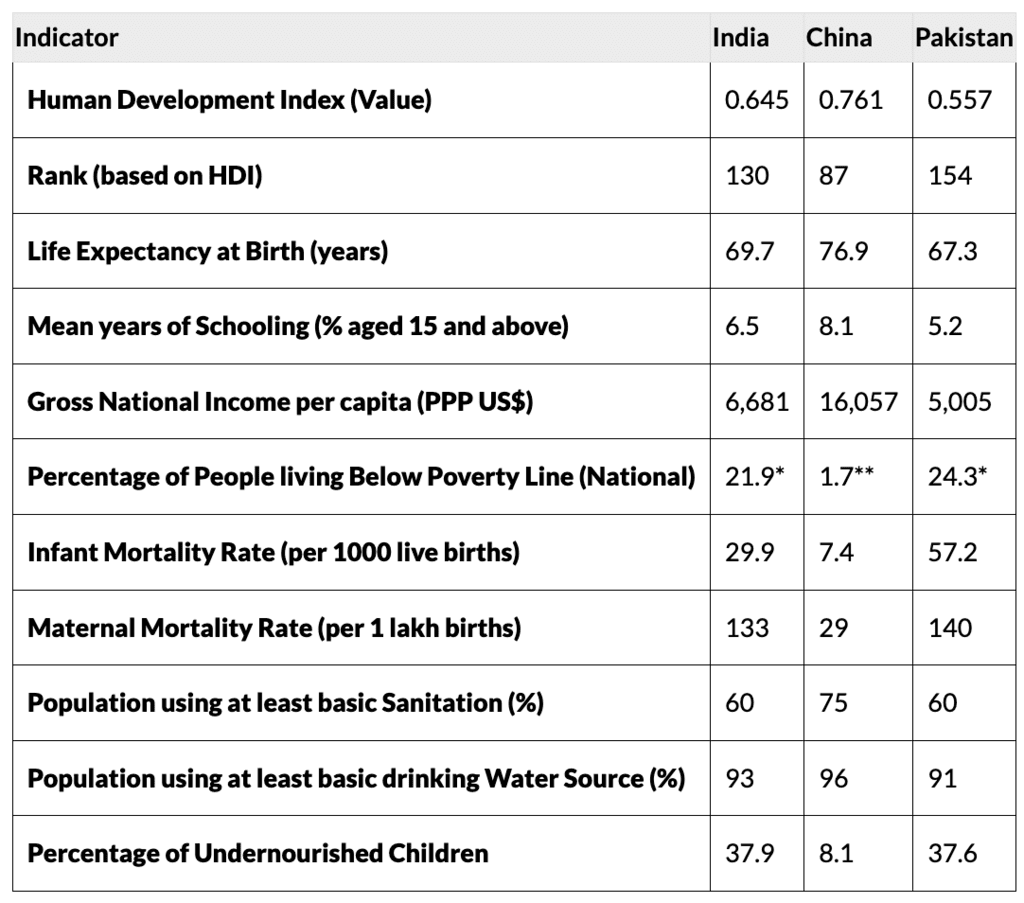
*For the year 2011; **for the year 2015.
Sources: Human Development Report 2019 and 2020, World Development Indicators (www.worldbank.org), Key Indicators for Asia and the Pacific 2019, Asian Development Bank (ADB).
Conclusion
India
India, with its democratic system, has seen moderate performance, yet a large portion of its population relies on agriculture.
- Many areas of the country lack proper infrastructure.
- Over 22% of the population lives below the poverty line.
- The maternal mortality rate is high, with 133 women dying for every 100,000 births.
- Urbanisation is moderate, with 34% of people living in cities.
Pakistan
Reasons for the slowdown in growth and renewed poverty in Pakistan include:
- Political instability.
- Unstable performance of the agriculture sector.
- Excessive reliance on remittances.
- Increasing reliance on foreign loans and difficulties in repayment.
- The maternal mortality rate is also high, with 140 women dying for every 100,000 births.
China
China has the smallest proportion of poor people among the three countries, as evidenced by:
- Success in increasing growth while reducing poverty.
- Utilising market mechanisms to create more social and economic opportunities without needing political commitment.
- By maintaining collective ownership of land and allowing personal cultivation, China provides social security in rural areas.
- Public intervention has positively impacted human development indicators in China.
- The maternal mortality rate is much lower, with only 29 women dying for every 100,000 births.
- High levels of urbanisation contribute to China’s economic growth.
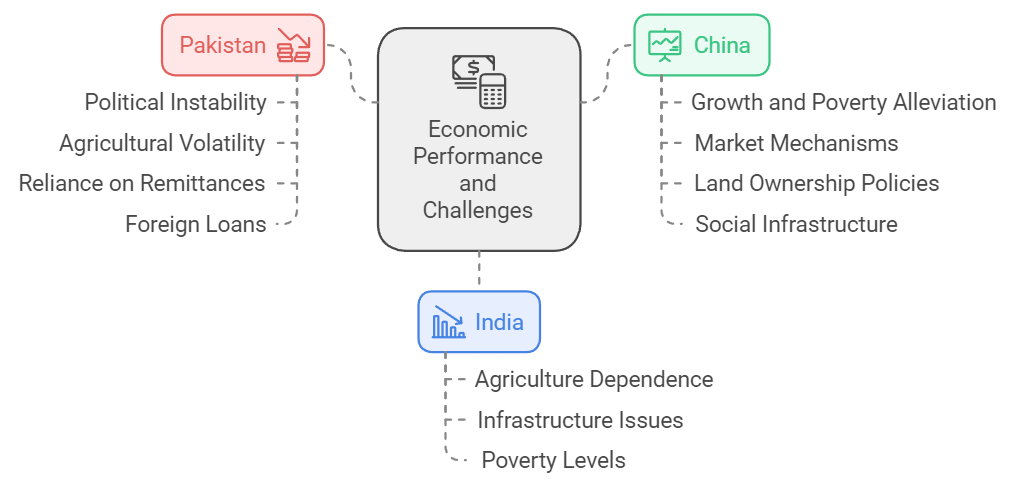
|
64 videos|308 docs|51 tests
|






















